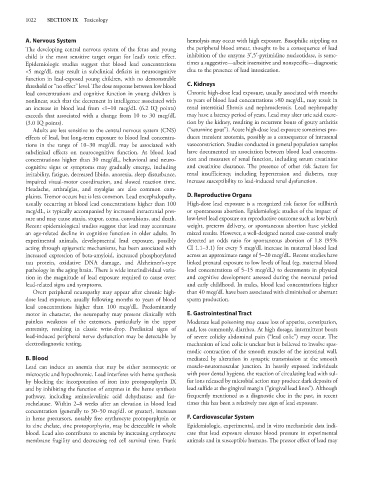Page 1036 - Basic _ Clinical Pharmacology ( PDFDrive )
P. 1036
1022 SECTION IX Toxicology
A. Nervous System hemolysis may occur with high exposure. Basophilic stippling on
The developing central nervous system of the fetus and young the peripheral blood smear, thought to be a consequence of lead
child is the most sensitive target organ for lead’s toxic effect. inhibition of the enzyme 3′,5′-pyrimidine nucleotidase, is some-
Epidemiologic studies suggest that blood lead concentrations times a suggestive—albeit insensitive and nonspecific—diagnostic
<5 mcg/dL may result in subclinical deficits in neurocognitive clue to the presence of lead intoxication.
function in lead-exposed young children, with no demonstrable
threshold or “no effect” level. The dose response between low blood C. Kidneys
lead concentrations and cognitive function in young children is Chronic high-dose lead exposure, usually associated with months
nonlinear, such that the decrement in intelligence associated with to years of blood lead concentrations >80 mcg/dL, may result in
an increase in blood lead from <1–10 mcg/dL (6.2 IQ points) renal interstitial fibrosis and nephrosclerosis. Lead nephropathy
exceeds that associated with a change from 10 to 30 mcg/dL may have a latency period of years. Lead may alter uric acid excre-
(3.0 IQ points). tion by the kidney, resulting in recurrent bouts of gouty arthritis
Adults are less sensitive to the central nervous system (CNS) (“saturnine gout”). Acute high-dose lead exposure sometimes pro-
effects of lead, but long-term exposure to blood lead concentra- duces transient azotemia, possibly as a consequence of intrarenal
tions in the range of 10–30 mcg/dL may be associated with vasoconstriction. Studies conducted in general population samples
subclinical effects on neurocognitive function. At blood lead have documented an association between blood lead concentra-
concentrations higher than 30 mcg/dL, behavioral and neuro- tion and measures of renal function, including serum creatinine
cognitive signs or symptoms may gradually emerge, including and creatinine clearance. The presence of other risk factors for
irritability, fatigue, decreased libido, anorexia, sleep disturbance, renal insufficiency, including hypertension and diabetes, may
impaired visual-motor coordination, and slowed reaction time. increase susceptibility to lead-induced renal dysfunction.
Headache, arthralgias, and myalgias are also common com-
plaints. Tremor occurs but is less common. Lead encephalopathy, D. Reproductive Organs
usually occurring at blood lead concentrations higher than 100 High-dose lead exposure is a recognized risk factor for stillbirth
mcg/dL, is typically accompanied by increased intracranial pres- or spontaneous abortion. Epidemiologic studies of the impact of
sure and may cause ataxia, stupor, coma, convulsions, and death. low-level lead exposure on reproductive outcome such as low birth
Recent epidemiological studies suggest that lead may accentuate weight, preterm delivery, or spontaneous abortion have yielded
an age-related decline in cognitive function in older adults. In mixed results. However, a well-designed nested case-control study
experimental animals, developmental lead exposure, possibly detected an odds ratio for spontaneous abortion of 1.8 (95%
acting through epigenetic mechanisms, has been associated with CI 1.1–3.1) for every 5 mcg/dL increase in maternal blood lead
increased expression of beta-amyloid, increased phosphorylated across an approximate range of 5–20 mcg/dL. Recent studies have
tau protein, oxidative DNA damage, and Alzheimer’s-type linked prenatal exposure to low levels of lead (eg, maternal blood
pathology in the aging brain. There is wide interindividual varia- lead concentrations of 5–15 mcg/dL) to decrements in physical
tion in the magnitude of lead exposure required to cause overt and cognitive development assessed during the neonatal period
lead-related signs and symptoms. and early childhood. In males, blood lead concentrations higher
Overt peripheral neuropathy may appear after chronic high- than 40 mcg/dL have been associated with diminished or aberrant
dose lead exposure, usually following months to years of blood sperm production.
lead concentrations higher than 100 mcg/dL. Predominantly
motor in character, the neuropathy may present clinically with E. Gastrointestinal Tract
painless weakness of the extensors, particularly in the upper Moderate lead poisoning may cause loss of appetite, constipation,
extremity, resulting in classic wrist-drop. Preclinical signs of and, less commonly, diarrhea. At high dosage, intermittent bouts
lead-induced peripheral nerve dysfunction may be detectable by of severe colicky abdominal pain (“lead colic”) may occur. The
electrodiagnostic testing. mechanism of lead colic is unclear but is believed to involve spas-
modic contraction of the smooth muscles of the intestinal wall,
B. Blood mediated by alteration in synaptic transmission at the smooth
Lead can induce an anemia that may be either normocytic or muscle-neuromuscular junction. In heavily exposed individuals
microcytic and hypochromic. Lead interferes with heme synthesis with poor dental hygiene, the reaction of circulating lead with sul-
by blocking the incorporation of iron into protoporphyrin IX fur ions released by microbial action may produce dark deposits of
and by inhibiting the function of enzymes in the heme synthesis lead sulfide at the gingival margin (“gingival lead lines”). Although
pathway, including aminolevulinic acid dehydratase and fer- frequently mentioned as a diagnostic clue in the past, in recent
rochelatase. Within 2–8 weeks after an elevation in blood lead times this has been a relatively rare sign of lead exposure.
concentration (generally to 30–50 mcg/dL or greater), increases
in heme precursors, notably free erythrocyte protoporphyrin or F. Cardiovascular System
its zinc chelate, zinc protoporphyrin, may be detectable in whole Epidemiologic, experimental, and in vitro mechanistic data indi-
blood. Lead also contributes to anemia by increasing erythrocyte cate that lead exposure elevates blood pressure in experimental
membrane fragility and decreasing red cell survival time. Frank animals and in susceptible humans. The pressor effect of lead may

